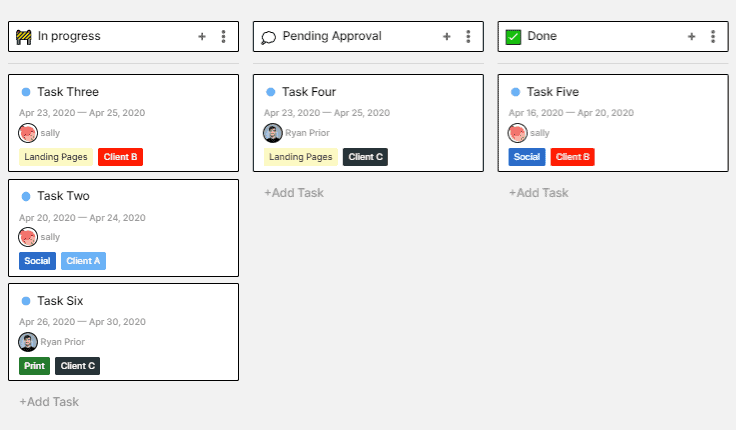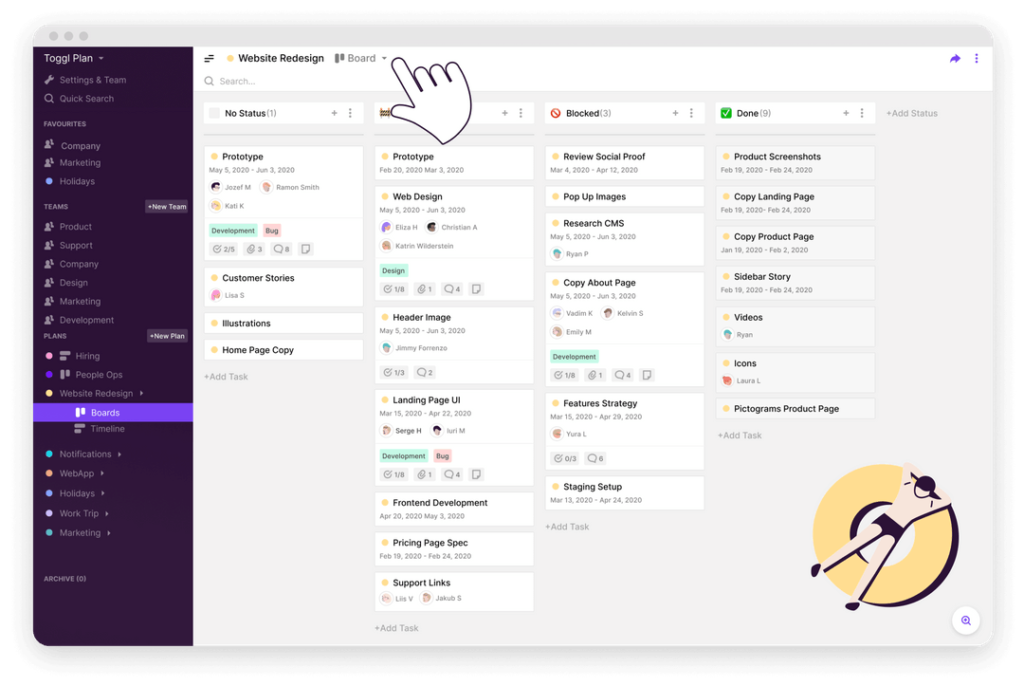Right now, project managers are falling in love with Scrum and Kanban boards. If you need a way to schedule your tasks and teams, either or both of these frameworks will do the trick. Whether you are working on your own from home or have a large team to manage, these boards will help you schedule your work as efficiently as possible.
If you are interested in using these systems, it’s worth spending time learning more about Kanban boards vs. Scrum boards. These two systems seem fairly similar when you first look at them, but there is a lot more to each of them than meets the eye. By picking the right program, you can improve your scope management and project completion rate.
What Is Kanban?
Before we can dive into this topic, we will first consider how Kanban boards work. On a basic level, Kanban is a tool you can use to organize your work in an efficient, effective manner.
Scrum and Kanban do have similarities in that both frameworks allow work to be divided into smaller chunks. This makes managing workloads easier for teams, which is one of the reasons why they are so popular among agile development teams.

Kanban is often used when Scrum doesn’t work for a team’s needs. Unlike Scrum, Kanban only limits the work you can do in any one condition, for example, only so many tasks can be on your to-do list. Scrum limits the time you have to finish any specific amount of work through its use of sprints.
When you use Kanban, you can visualize the workflow. You can see how your team is progressing on different chunks of the project with a Kanban board.
What Is Scrum?
Scrum is a framework for managing teams, that includes learning loops for easily integrating customer feedback. Scrum teams work together in intervals known as sprints.
Within the team, people can carry out different roles and hold ceremonies to keep the project moving forward. Teams can also make special artifacts. When you compare a Kanban team vs Scrum team, the most obvious difference is how Scrum teams have set required roles.
How Are Kanban and Scrum Different?
Before you can start working as a team, you have to figure out the answer to, “What is the difference between Kanban and Scrum?” At their heart, both of these programs revolve around the idea of agile development.
With this practice, project managers use an iterative approach and user stories. Basically, this tactic uses milestones and self-organizing teams instead of a big-picture, overarching approach to each project. Because of this fast, nimble methodology, agile developers have a competitive advantage and can complete long projects in a short amount of time.
When considering Kanban vs. Scrum, it is important to consider your goals. Kanban is all about limiting the amount of work in progress and visualizing your work. You are able to maximize your workflow by reducing the time it takes to finish a user story.
With Scrum, the project is divided into set intervals known as sprints. Each of these intervals is like a learning loop, which helps the team learn and absorb feedback. The difference between Scrum and Kanban is in how projects are carried out and how flexible the program is for sudden changes.
Team Roles
One obvious difference between Scrum and Kanban is the team itself. When you use Kanban boards, there are no key role requirements because the structure is quite fluid. Instead, you are just recommended to have a project manager.

While Kanban doesn’t have any required roles, Scrum is the opposite. When you create the project’s workflow, you have to assign key roles. These roles are for the development team, Scrum master and product owner.
The development team is responsible for doing the tasks listed in the daily stand-up. While your development team must achieve your daily and overall goals, the product owner is the person who sets those goals. Then, the Scrum master is in charge of managing the timeline.
If you are trying to choose between a Kanban team vs Scrum team, the role requirement is an important consideration. Kanban is used when Scrum doesn’t work for teams, and you want a more fluid option. No matter which option you choose, both of the programs still involve some kind of teamwork for achieving objectives.
Scheduling
Since Kanban and Scrum are both broadly systems for managing your workflow, the difference between their deadlines, prioritization, and cadence are key to comparing the two programs. Kanban places a strong focus on prioritization because the project is expected to evolve and change over time. In comparison, Scrum expects you to clearly delineate your goals within your sprint, so you shouldn’t change the schedule as you go along.
Kanban allows you to create project deadlines, processes, roles, allowances, and restrictions for your project. These variables can be easily addressed and changed as your project’s needs change.
Unlike Kanban, Scrum has a strict focus on the schedule. You are expected to be disciplined and stay within the focus of your pre-set schedule and priorities. The team decides the point allocation they want, and then they stick to it.
If you use Scrum, you have to have a strong understanding of your team’s capabilities and goals. Each sprint requires a deliverable, and your scope must be accurately predicted if you want to complete your deliverable. In Scrum, beating your deadline isn’t encouraged either because you are supposed to complete your goals during the sprint.
Cadence
Cadence is another important difference between Scrum and Kanban. Scrum generally moves faster because sprints are around two to four weeks in length. Each sprint has a clear date for starting and ending.
Because Scrum has short time frames, it makes it easier to deal with complex tasks. These tasks are divided into smaller stories your team can handle quickly. Each sprint includes sprint planning, sprint review, daily Scrum meetings, and retrospective meetings.
With Kanban, there is a continuous flow. The work items are on cards on the Kanban board. Each card flows smoothly into another stage of the workflow. In Toggl Plan, you can quickly drag-and-drop tasks from one status to another, and add color-coded tags to visualize each type of task.

When you use Kanban, you can create custom columns. In the example screenshot above, a graphic design agency is using columns to identify which tasks are in progress, which are pending approval, and which are done. Tags are used to differentiate between different types of design (print, social, web, and so on). Using these boards can help you spot bottlenecks in your process, so your team can improve.
Boards
How you set up your boards will be different in each system, too. Again, these will look similar at first glance, but there are a number of key differences in how the columns and other features work.
When you look at the Scrum board, you will notice columns. These columns have labels to show the start of the sprint backlog and all of the steps until the end of the project. The user stories within the sprint should end up within this final column, or the sprint didn’t achieve its goals successfully.
With a Kanban board, the columns are labeled to reflect different places in the workflow. They also show the maximum number of stories you can put in a column at any given point in time. Because team members can keep adding new stories, the workflow board can keep flowing as the project unfolds instead of dealing with limitations like sprint length.

Toggl Plan’s boards feature is designed for project managers and agile teams. Whatever your work planning style, boards will allow you to set custom column statuses, add tags, and get a clear overview. Even better, switch over to timeline view to get a beautiful birds-eye-view of your team’s work. Quickly react to changes using an intuitive drag-and-drop interface.
Change Philosophies
With Kanban, teams can make changes at any time. Whenever you want, you can add new work items to your project’s backlog. Then, you can remove existing cards and adjust your WIP limit as needed.
When you use Scrum, you aren’t supposed to make changes during your sprint. Instead, you get feedback and adjust for your next sprint. You get a chance to discuss making future changes during your sprint retrospective at the end of each iteration.
When Should You Use Each One?
Once you learn more about Kanban boards vs. Scrum boards, the next step is determining which one you want to use with your team. Kanban or Kanban can be used for small and large teams. Each system has its benefits and drawbacks.
If you need flexibility and the ability to change, Kanban is the right choice for you. Scrum has a rigid focus on sprints and deadlines, so you won’t be able to change things when you need to. If your team likes to do everything in a certain order and has a clear understanding of the project’s scope, Scrum may be the best choice.

When choosing between Kanban vs. Scrum, you may also need to consider the depth of your project. Scrum is popular for large projects and long-term projects. Meanwhile, Kanban generally works better for small-scale projects.
If you want customized columns and flexible team roles, you may want to look into using Kanban. This system allows you to make changes as you go along, and any team member can perform any role. If you use Scrum, you will get assigned team roles as well as a fixed schedule to follow.
Choosing the Right System for Your Team
While there are many different systems out there designed to work with agile methodologies, your team should only use one of them to keep everyone on the same page. Trying to choose between Kanban boards vs. Scrum boards can be challenging if you haven’t used either system before. Both options will allow you to organize your team and create new iterations of your project’s workflow.
If you want to use one of the world’s leading systems for scheduling your workflow, check out Toggl Plan. Our software is an easy-to-use tool that gives you a beautiful overview of your teams and tasks. Create boards and timelines, share plans with key colleagues & clients, and make back-and-forths a breeze. It’s so simple, your team will actually use it.
Get started for free with Toggl Plan today!
Logan Derrick is a full-time business writer and content marketing strategist. For years, he has worked closely with several project management professionals, learning from them and increasing his own knowledge of the industry. Having held multiple management positions in fields ranging from customer service to marketing, Logan has found a passion for helping others learn about project management, marketing, and the powerful tools available to professionals today.


